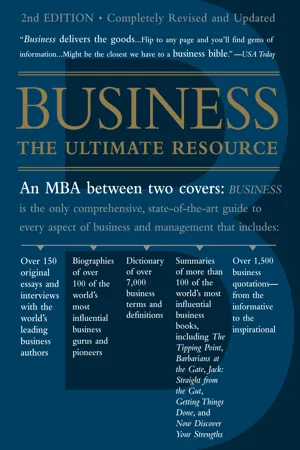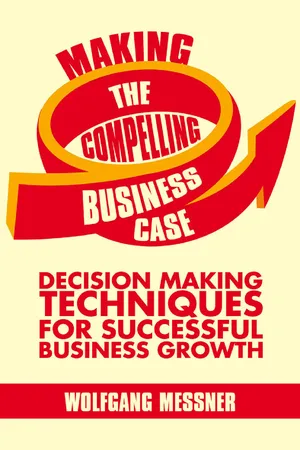Future Value
Future value refers to the projected value of an investment or asset at a specified future date, based on the assumption of a certain rate of return. It is a crucial concept in finance and investment decision-making, as it helps in evaluating the potential growth and profitability of an investment over time. Calculating future value assists businesses in making informed financial planning and investment choices.
8 Key excerpts on "Future Value"
- eBook - ePub
Business
The Ultimate Resource
- Bloomsbury Publishing(Author)
- 2011(Publication Date)
...Calculating Future Value WHAT IT MEASURES The potential value of a sum of money in the future given certain parameters. WHY IT IS IMPORTANT Future Value is a fundamental of investment. Understanding it helps any organization or individual to determine how a sum will be affected by changes in inflation, interest rates, or currency values. Inflation, for instance, will always reduce a sum’s value. Interest rates will always increase it. Exchanging the sum for an identical amount in another currency will increase or decrease it, depending on how the respective currencies perform on the world market. Armed with this knowledge, an organization can make more informed decisions about how to generate the maximum value from its funds in a given period of time: Would it be best to deposit them in simple interest-bearing accounts, exchange them for funds in another currency, use them to expand operations, or use them to acquire another company? HOW IT WORKS IN PRACTICE Start with three figures: the sum in question, the percentage by which it will increase or decrease, and the period of time. In this case: $1,000, 11 percent, and two years. At an interest rate of 11 percent, our $1,000 will grow to $1,232 in two years: $1,000 × 1.11 = $1,110 (first year) × 1.11 = $1,232 (second year, rounded to whole dollars) Note that the interest earned in the first year generates additional interest in the second year, a practice known as compounding. When large sums are in question, the effect of compounding can be significant. At an inflation rate of 11 percent, by comparison, our $1,000 will shrink to $812 in two years: $1,000 / 1.11 = $901 (first year) /1.11 = $812 (second year, rounded to whole dollars) TRICKS OF THE TRADE • Express the percentage as 1.11 and multiply and divide by that figure, instead of using 11 percent...
- eBook - ePub
Mastering Corporate Finance Essentials
The Critical Quantitative Methods and Tools in Finance
- Stuart A. McCrary(Author)
- 2010(Publication Date)
- Wiley(Publisher)
...However, this chapter and much of this book rely on cash flows for a completely different analysis and treat the cash flows from a project or even the cash flows of an entire corporation much like the cash flows of a bond. With a bond, investors transfer money today to borrowers, who in turn pay interest and eventually repay the loan. The size and timing of the cash payments and cash receipts determines the attractiveness of the bond investment. The techniques described herein will enable investors to evaluate the cash flows of any investment regardless of when the cash flows occur. Future Value The Future Value of a cash flow is the value at some specified future time of a cash flow that occurs immediately. The concept of Future Value allows a company to decide whether cash flows that occur at two different times are equivalent. The way in which the two cash flows are equivalent is the subject of this chapter and will be explained subsequently. Suppose that a company issues a bill that requires a customer to pay $100 upon receipt. The customer asks for extra time to pay. The company can borrow at an 8 percent interest rate. The company tells the customer that it will accept $102 instead in three months. The company calculated the amount of cash it would accept that would be equivalent to getting $100 immediately. If the delay in receiving payment causes the company to borrow $100 for three months, the company must account for the interest on the loan. The formula for interest might look like Equation 1.1. (1.1) This is a formula for simple interest. Simple interest applies the interest rate to a principal balance for a period of time. The formula begins with the principal balance multiplied by the annual interest rate of 8 percent or $8. However, the rate applies only to three months or one-quarter of the year...
- eBook - ePub
Making the Compelling Business Case
Decision-Making Techniques for Successful Business Growth
- W. Messner(Author)
- 2013(Publication Date)
- Palgrave Macmillan(Publisher)
...2 Key Financial Concepts When companies execute their corporate strategy, they search for assets, investments, or projects that are worth more to them than others. Unfortunately, in most cases they can only guess what the asset will be worth once they commission it and take it under their management. Therefore, financial managers and decision makers need to know how asset values are determined, today and in the future. They need to construct, understand, and apply a theory of value; in other words, they need to initiate a business case project. This chapter provides an overview of key financial concepts. It first develops a theory of value and then moves on to outline selected financial models. These frameworks can be used first to capture investment ideas and scenarios and then to justify a decision using monetary terms and criteria. 2.1 TIME VALUE OF MONEY The well-known and often quoted maxim A dollar today is worth more than a dollar tomorrow is probably the number one basic principle of finance. It is this simple because today’s dollar can be invested to start earning interest immediately. And tomorrow’s dollar can only be invested tomorrow: it is not available today and will thus lose out on immediate interest earnings. Look at an example. If you were to invest $500,000 in government securities at an interest rate of, say, 5 per cent per annum (p.a.), a year from now you would receive: $500,000 · (1 + 0.05) = $525,000 Thus, the Future Value (FV) of $500,000 today is $525,000 a year from now...
- eBook - ePub
Introduction to Fixed Income Analytics
Relative Value Analysis, Risk Measures and Valuation
- Frank J. Fabozzi, Steven V. Mann(Authors)
- 2010(Publication Date)
- Wiley(Publisher)
...When we calculate a Future Value, we ask how much will the dollars invested today be worth in the future given a particular interest rate. So, the mathematics of Future Value involve multiplication by a value greater than one (i.e., making things bigger). Correspondingly, when we find present values, we ask how much a future amount of dollars is worth today given a particular interest rate. Thus, the mathematics of present value involve division by a value greater than one (i.e., making things smaller). The general formula for the present value (PV) of a single cash flow N years in the future given an interest rate i is (1.2) Note that we have replaced P with PV. In addition, PV does not have a subscript because we assume it is the value at time 0 (i.e., today). It is instructive to write the expression for the present value of a single cash flow as follows The term in brackets is equal to the present value of one dollar to be received N years hence given interest rate i and is often called a discount factor. The present value of a single cash flow is the product of the cash flow to be received (FV N) and the discount factor. Essentially, the discount factor is today’s value of one dollar that is expected to be delivered at some time in the future given a particular interest rate. An analogy will illustrate the point. Suppose a U.S. investor receives cash payments of $200,000, ¥500,000, and £600,000. How much does the investor receive? We cannot simply add up the cash flows since the three cash flows are denominated in different currencies. In order to determine how much the investor receives, we would convert the three cash flows into a common currency (say, U.S. dollars) using currency exchange rates. Similarly, we cannot value cash flows to be received at different dates in the future merely by taking their sum. The expected cash flows are delivered at different times and are denominated in different “currencies” (Year 1 dollars, Year 2 dollars, etc.)...
- eBook - ePub
The Capital Budgeting Decision
Economic Analysis of Investment Projects
- Harold Bierman, Jr., Seymour Smidt(Authors)
- 2012(Publication Date)
- Routledge(Publisher)
...Chapter 2 The Time Value of Money The frenetic buying of Internet stocks is going to make the tulip buyers of the 17th century look like value players. Rick Berry, director of equity research at J. P. Turner & Company in Atlanta. The New York Times, January 9, 1999 Compound interest is one of the wonders of this world. It is the basis of the present value calculations. The Safra Bank issued bonds that mature in 1,000 years. The present value of $1,000,000,000 of principal payments of this bond at a 0.08 annual interest rate is much less than $0.01. Compound interest is very powerful. A future sum may have a very small present value. A very small present amount might grow to a large sum in the future. To better understand the time value of money, we shall first assume that both the discount rate and the dollar amounts are known with certainty. These assumptions enable us to establish basic mathematical relationships and to compute exact relationships between future sums and their present values. Time Discounting One of the basic concepts of business economics and managerial decision-making is that the present value of an amount of money is a function of the time of receipt or disbursement of the cash. A dollar received today is more valuable than a dollar to be received in some future time period. The only requirement for this concept to be valid is that there be a positive rate of interest at which funds can be invested or borrowed. The time value of money affects a wide range of business decisions, and how to incorporate time value considerations systematically into a decision is essential to an understanding of finance. The objective of this chapter is to develop skills in finding the present equivalent of a future amount or future amounts and the future equivalent of a present amount. Symbols Used X Cash flow. If X is greater than zero there is a cash inflow. If X is less than zero, there is a cash outflow. t Time index...
- eBook - ePub
- Curtis M Jolly, Howard A Clonts(Authors)
- 2020(Publication Date)
- CRC Press(Publisher)
...This is because of time value of money. The process of finding present value is called discounting. The time value of money influences many production decisions. Everyone prefers money today over money in the future. Therefore, in order to invest a dollar in fish production today, one must be guaranteed a return in the future that is equal to or greater than the dollar invested today. The preference for the dollar now instead of a dollar in the future arises from three basic reasons: uncertainty, alternative uses, and inflation. Uncertainty influences preference because one is never sure what will take place tomorrow. The alternative uses will determine whether one invests in one project or another, and inflation affects the purchasing power of the dollar. The interest rate (i) is considered an exchange price between present and future dollars. Thus, $1.00 today exchanges for 1+i dollars one period in the future. Or alternatively, a $1.00 payment-made one period in the future exchanges for 1/1 + i dollars now. Interest rates equate present and future claims for financial assets of different maturities. These rates respond to changes in supply and demand for alternative financial assets, including money, just as other commodity prices respond to changes in their supply and demand. Interest rates are always positive because of the positive time preference for money. The positive time preference means the sooner money is available, the greater its value. Future Value OF A PRESENT SUM — COMPOUNDING In the example given earlier, one time period was examined, that is, 1 year. If a dollar were invested today at an interest rate of 6.0 percent per annum, what will be the value 2 years hence? Would it be $1.20 or $1.12? The value $1.12 is based on the simple interest rate; that is, only the original amount of money ($1.00) earns interest over the 2 years. However, in real business, interest is earned on the original amount plus the interest income...
- eBook - ePub
- Robert Irons(Author)
- 2019(Publication Date)
- Routledge(Publisher)
...How much greater than one it is will depend upon the interest rate used and the number of periods in the future required. This will be shown in greater detail in the section “Future Value and Compounding.” Discounting, or calculating present values, results in cash flows growing smaller the further back in time the value is calculated. For this reason, the multiplier used to calculate the present value of a single cash flow will be less than one. How much less than one it is depends upon the interest rate used and the number of periods back in time required. This will be made clear in the section “Present Value and Discounting.” Figure 2.1 The Future Value of $1,000 Invested to Earn 5% APR Over One Year Note that discounting involves the removal of value over time. The value removed represents the return that would be earned by the money if it were available to be invested today. In later chapters, you will see that: The present value of a bond is calculated by removing the required yield on the bond over the life of the bond; The present value of a stock is calculated by removing the required return on the stock; The present value of a production project is calculated by removing the cost of money to all investors (bond holders and shareholders); and The present value of the firm is calculated by removing the cost of money to all investors (bond holders and shareholders). Thus, when valuing an asset, the purpose of discounting is to account for the return the firm owes to its investors for being able to use their money. In this chapter, we will be valuing future cash flows, and in this case the discount rate represents the opportunity cost of the investment—the yield on the next best investment available. A tool that is helpful in time value calculations, particularly for complex time value problems, is the time line...
- eBook - ePub
- Brümmer LM, Hall JH, Du Toit E(Authors)
- 2017(Publication Date)
- Van Schaik Publishers(Publisher)
...143 9 The time value of money Learning outcomes After studying this chapter, you should fully grasp the meaning of the time value of money understand the concepts of future and present values know how to calculate future and present values understand the concepts of the future and present value of annuities know how to calculate the future and present value of annuities understand the concept of amortisation. Introduction Although at first glance the time value of money may not appear to be related to the reading and analysis of financial statements, it has a direct bearing on the financial statements. To explain this remark, let us find an example that would require application of the principle of the time value of money. Let us consider the investment of working capital in accounts receivable, one of the current assets in the Statement of Financial Position. When an organisation allows its debtors to buy on credit, the organisation is, in effect, making an investment in accounts receivable because the organisation’s money will be tied up or invested in accounts receivable until the debtors pay their accounts. The investment ends when debtors settle their accounts, and accounts receivable finally become cash. The concept of the time value of money When debtors settle their accounts late, the time value of the money invested in accounts receivable becomes important. The concept of the time value of money simply means that it is more profitable, and therefore preferable, to receive money now rather than at some time in the future. 144 There are two reasons for this preference. The first concerns risk. The longer a creditor has to wait for his money, the greater is the chance or risk that some problem will arise to cause financial loss. An example of such a problem would be the debtor being declared insolvent before paying his debt. The second reason concerns the opportunity cost of capital...







